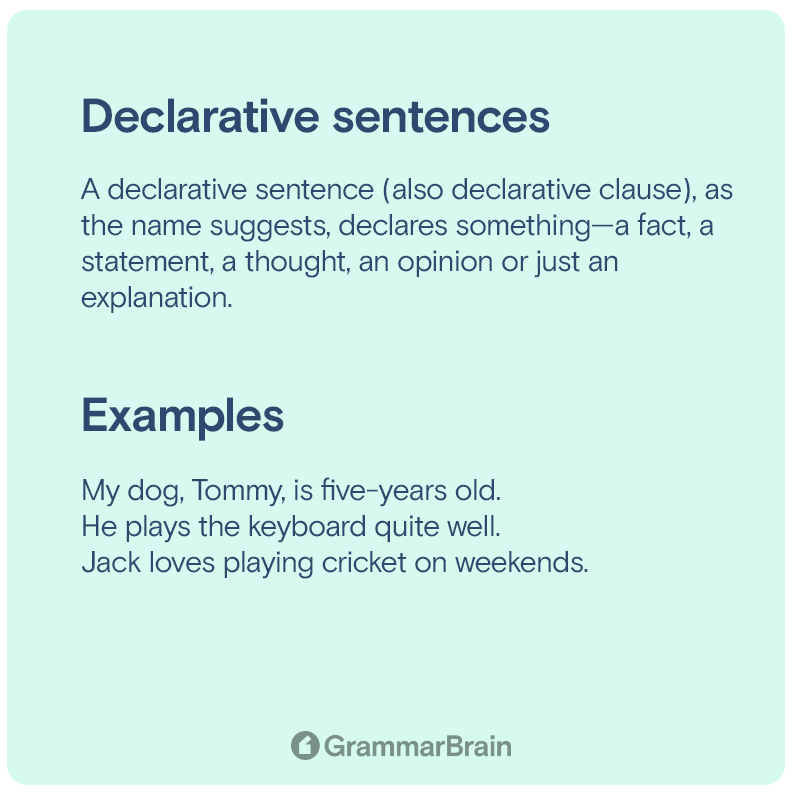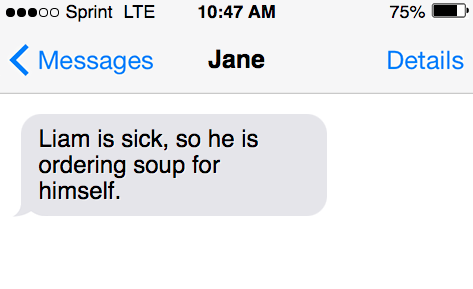

The key to good writing is the ability to convey meaning, tone and purpose without ambiguity. This requires standardized rules about sentence structure, usage and punctuation.
The English language has four types of sentences based on its function—declarative, interrogative, exclamatory and imperative.
For the purpose of this article, let’s first discuss declarative sentences, their types, examples and usage rules before briefly exploring other types of sentences.
Try the practice quiz at the end to test your knowledge on the declarative sentences.
| Interrogative | Declarative | Imperative | Exclamatory |
| Asks a question | Tells a statement | Gives a command | Shows excitement |
A declarative sentence (also declarative clause), as the name suggests, declares something—a fact, a statement, a thought, an opinion or just an explanation.
Structured like a regular sentence, declaratives sentences have the subject precede the verb and are usually written in the present tense. It is also always followed by a period.
When you need to declare a statement that conveys some kind of information to the reader, you can use declarative sentences.

A compound declarative sentence as the name suggests joins two independent clauses that declare a statement using a conjunction.

Complex declarative sentences have a single independent clause and two or more dependent clauses which declare a statement.

Like any other regular sentence, a declarative sentence has a subject, predicate and punctuation.
The subject is a person, place or thing who performs the main action in the sentence. It can be a noun, pronoun or noun clause that acts on the verb of the sentence.
The predicate contains the verb and the main clause of the sentence.
In declarative sentences, the subject will precede the main clause.
Punctuation is also a defining differentiation that helps identify the type of sentence. Declarative sentences always end with a period and never with a question mark or exclamation point.
The word imperative means “giving an authoritative command”. Imperative sentences are used to tell somebody to carry out a particular action. Use it to communicate commands, orders, requests, instructions to a person, pet or thing.
When your teacher assigns homework, when your mother asks you to clean your room, when your parent’s boss asks them to finish a work or when you tell a friend to pick you up at home— You will be using imperative sentences.
Imperative sentences always end with a full stop.
Interrogative sentences are those that ask a question and elicit a response from the addressee.
They are usually structured with an auxiliary verb, subject and the main verb.
E.g. Do you speak Spanish?
Interrogative questions can use any tense and may have a positive or negative connotation.
Rhetorical questions i.e. those that resemble questions but the speaker does not seek a response but instead uses it to make a point. So, these types of questions are not considered interrogative.
Also remember that indirect questions are not interrogative. E.g. She asked me if I was coming to the wedding. This is a declarative sentence and not an interrogative one.
An easy way to identify is that interrogative sentences always end with a question mark.
Exclamatory sentences are used to express a heightened emotion like a sudden feeling of surprise, excitement, happiness, pain, anger or any other emotion.
You can easily identify an exclamatory sentence as it always ends with an exclamation mark.
Apart from the mood, exclamatory sentences will have intonation and inflection on certain words or syllables as it expresses the intensity of emotion.
Exclamatory sentences can use interjections such as “Ouch”, “Yikes” and “wow” which can have their own exclamation point or be connected to the rest of the phrase with a comma.
Use exclamatory sentences in casual writing and try to avoid them in formal contexts.
Sentences come in differing lengths and types but they are not merely used for variability. It is the purpose of the sentence and the meaning it conveys that determines the type of the sentence.
Long sentences can be used for descriptive purposes while shorter ones are more impactful. The four types of sentences that we saw above each have their own function and purpose.
Declarative sentences are basic building blocks of writing—establishing context, delivering meaning and purpose. They address the reader in a direct way and convey the information without any ambiguity.
This is why declarative sentences are one of the most commonly used sentences from creative, academic to business contexts.

A simple declarative sentence is a sentence that consists of a subject and a predicate.